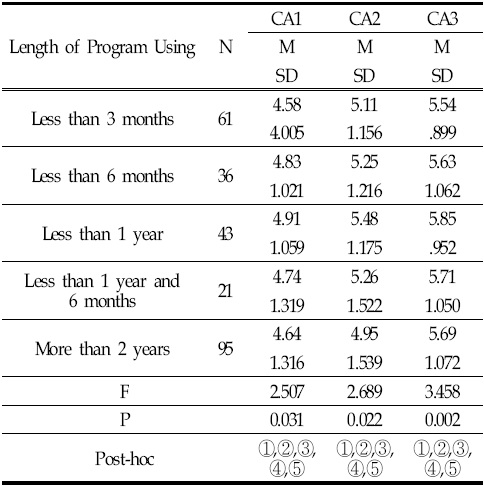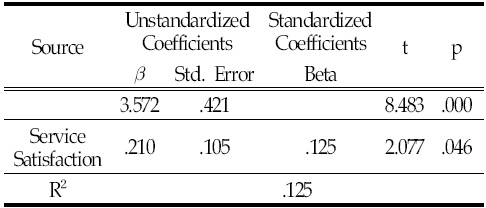


본 연구는 지역의 공공여가시설 프로그램 참여자의 서비스 만족과 지역애착도에 대한 관계를 규명함으로써, 이를 바탕으로 공공여가시설 프로그램의 운영개선 방안을 제시하는데 그 목적이 있다. 본 연구의 조사대상은 서울시 6개 구민회관 여가 프로그램 참여자를 포집하였으며, 총 257명의 자료를 최종 분석 자료로 사용하였다. 공공여가시설 프로그램의 서비스 만족이 지역애착도에 영향을 미칠 것이라는 가설을 설정하고 이를 검증하고자 SPSS(Ver.12.0) 통계프로그램을 이용하여, 빈도분석, 요인분석, 상관관계분석 및 회귀분석을 실시하였다. 위와 같은 통계방법을 통하여 다음과 같은 결과를 도출하였다. 첫째, 프로그램 참여자의 인구통계학적 특징 중 성별, 프로그램 참여기간, 거주기간은 서비스 품질만족 및 지역애착도에 영향을 미치는 것으로 나타났다. 둘째, 공공여가시설의 서비스 품질과 서비스 만족의 관계검증에 있어서, 서비스 품질의 하위 요인 중 유형성, 능력성, 대응성, 능률성, 편리성은 서비스 만족에 긍정적인 영향을 미치는 것으로 나타났다. 셋째, 서비스 만족과 지역애착도의 관계검증에 있어서, 서비스 만족은 참여자의 지역애착도에 긍정적인 영향을 미치는 것으로 나타났다.
As nations have achieved significant economic growths in the 21st century, leisure has emerged as a core determinant of national competitiveness (Korea Ministry of Culture and Tourism, 2008). Recreation and leisure are important elements in measuring the quality of life at both the individual and societal level (Iso-Ahola, 1980; Neulinger, 1981; Moore and Graefe, 1994). Leisure can serve various purposes based on individual freedom and choice, but is used chiefly to meet one’s personal needs for reflection, self-enrichment, relaxation, or pleasure (Kraus, 1998). Like all human activities, how we use leisure has the potential to make both positive and negative impacts on individuals, families, groups, communities, and society.
Last few years, government has increasingly acknowledged the importance of public leisure services to grant public spaces and leisure facilities a broader ideological significance. Many in the field of leisure studies have viewed the increased public provision for leisure as part of the evolutionary process of the citizenship development (Coalter, 1998). Moreover, leisure was, and continues to be, a means through which the state can mold individuals into the ideal citizen (Glover, 2002).
The changing perceptions on leisure in societies and counties around the world has influenced the objectives of public administrations. Leisure has allowed the government functions to operate on a smaller scale, at less costs, and stronger all at the same time while achieving to meet the needs of the people and to hold the nation’s ideology (Shin, 1998).
It is obvious that cities with higher quality and quality of services may be perceived more favorably by their citizens than fewer and poorer services (DeHoog and Lyons, 1989). Indeed, public recreation agencies continues to combine the pleasure of participation in leisure activities with enduring social values, social trust, and civility, to potentially enrich individuals, groups and communities. In so doing, government has assumed a direct role in the delivery of leisure service (Glover, 2002).
In recent days, entrepreneurship and business management techniques are introduced in the public sector (Kim, 1996; Shin, 1998). These attempts allow us to consider the administrative agencies as the state service enterprises, which provide services to customer, managed by policy and government management officials (Lee, 1998; Shin, 1998).
A number of research studies have examined the degree to which recreation and leisure contribute to residents’ satisfaction with community life (Kraus, 1998). Lee and Lee (2010) analyzed that public sports facilities are an important factor in establishing a resident’s sense of belonging and attachment, which then will create a sense of sovereignty and community in the neighborhood to boost mutual exchange of information in local community. Demers (1994) also emphasized that the greater personal experience with one’s community, the greater the attachment to the community.
Evidently, leisure participation is not just about individual welfare; the act and process of participation are central to the idea of the citizen (Coalter, 1998). Moreover, within the different levels of government, municipalities are considered as the closest to citizens. Local communities also value the quality of life according to their municipality’s ability to provide services that maintain the welfare for its citizens (Giannoccaro, Costantion, Ludovico, & Pietroforte, 2008).
Community centers are facilities which provide public services related to culture, welfare, education and sports and have a symbolic meaning of its district (The Seoul Metropolis, 1997). However, relatively few studies have been devoted to public leisure service programs in district community center.
This study tried to indicates that the public leisure service has its function lies beyond merely enriching the quality of life in the community. It could be a tool to strengthen neighborhood and community life (Kraus, 1998). It is important to study the public leisure service quality in order to provide effective programs for the residents in the city. The limitations of the study may appear, First, the research focuses on community centers as case of public leisure service, it is inappropriate to generalize entire public leisure service. Second, the study site focuses on 6 community centers in 5 district zone of Seoul, it is not legitimate to extended nationwide. And last, the study could not compensate other resources that can effect community attachment to resident.
The study attempts to investigate,
(1) Relationship of participant’s background characteristics, service quality, service satisfaction and community attachment.
(2) Relationship between participant’s perception of public service quality and service satisfaction.
(3) Resident’s satisfaction of public leisure service and its relationship with their community attachment.
The followings are constructs used in the study,
The purpose of public leisure service is to improve the people’s welfare by providing leisure service to the pubic. The facilities are established and controlled directly by government and public organization. They divided into ranges of culture, physical education, welfare and education (Korea Ministry of Culture and Tourism, 2008).
Service quality is determined by the difference between customers’ expectations of service provider’s performance and their evaluation of the service received. Bolton and Drew (1991) defined customers’ service quality as the difference between the actual service performance and their expectations. Parasuraman et.al., (1988) characterized perceived service quality as “the degree and direction of discrepancy between customers’ perceptions and expectations”.
Scholars describe service satisfaction as an evolution of an emotion suggesting that is reflect the degree to which consumer believe that using a service evokes positive feeling (Hunt, 1977; Rust & Richard, 1995; Jen and Lu, 2003).
Community attachment refers to a sentiment-based emotional connection to community (Theodori, 2000). Karsada and Janowitz (1974) defined community attachment as the level of emotional experience and bonds that an individual or a group of individuals have toward their community.
The survey was conducted to the residents who are participating in leisure programs; health programs, music programs, language classes and arts and cultural classes which organized by their province district office. The survey was distributed in the period from September to November 2010. Three zones (South-East, Central, North-East) have been selected by cluster sampling from the five zones of Seoul (South-East, North-East, Central, South-West, North-East). From each zone the study selected two districts in South-East (Seocho-gu, Gangnam-gu), two districts in Central (Jongro-gu, Jung-gu), two districts in North-East (Seongbuk-gu, Dongdaemun-gu) by using convenience sampling. To collect the necessary date for research questionnaires the survey adopted self-administration method. 271 questionnaires were distributed, and a total of 257 questionnaires were considered valid and used in the study.
<Table 1> indicates the respondents background characteristics. The sample was 14.7% male and 77.7% female. Approximately 32.4% of the respondents were aged 50 or older, 28.8% were in their 40s, 23.4% were in 30s and only 7.6% were in their 20s. 55.8% participants listed their occupation as housewife, 10.4% participants as private business owners, 9.4% as employed workers, 6.1% as unemployed or other, 6.1% as professional job and 4.6% as students. Over half of respondents listed their income level is greater than 3 million Won per months, 3.2% listed below 1 million won, 6.8% listed 1 million to 1.5 million won and 20.5% listed between 2 million to 3 million won. For the length of program using, over 40% of the respondents used the program for longer than 1 year, 34.2% participants used program longer than 2 years, 34.8% participants used less than 6 months and 15.5% used for less than a year. For their length of residence, 32.0% of the participants listed lived between 1 to 5 years and over two third of the participants listed lived in the district lover than 6 years.
[Table 1.] Respondent’s Background Characteristics
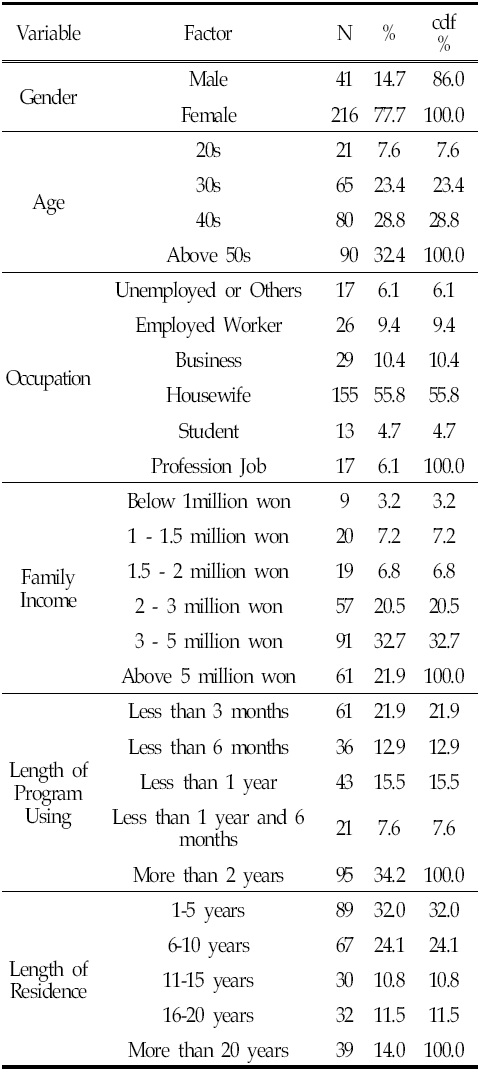
Respondent’s Background Characteristics
The survey instrument composed of community center program participant’s background characteristics, service quality measurement, service satisfaction of public leisure service and community attachment.
Evaluating service quality is by comparing what the customer have received and what they expect to receive, Parasuraman et.al., (1985) first published their research on measuring and managing service quality (SERVQUAL). Wagenheim and Reurink (1991) conducted this service quality model to public service. The research modified the variables and regenerated into public service quality. The service quality composed of 16 questions based on 7 factors. It used seven-point Likert-scale to measure its variables. The survey set measured an overall satisfaction level of public leisure service, used five-point Likert-scale.
Community attachment was measured using the community attachment scale developed by Karsada and Janowitz (1987). The scale has been translated into Korean and modified by Kang (2001), Han (2005), Kim (2006) and Ahn (2008). The study compensated the scale and conducted the 12 questions, used seven-point Likert-scale. <Table 2> indicates the factors and questions in the survey.
3. Test Reliability and Validity
The Study performed the factor analysis to discover the nature of constructs influencing a set of responses. The study conducted principal axis factor analysis with Varimax rotation to determine the structure of the service quality and community attachment. A measure of scale reliability Cronbach’s alpha coefficient was used to test the reliability of the construct.
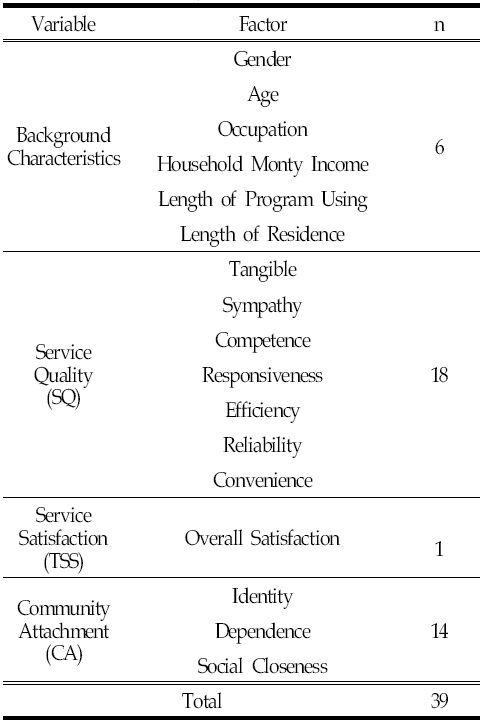
Research Survey
1) Service Quality
The factor analysis revealed that three items were loaded on convenience variable which yielded values between .612~.989, three items were loaded on reliability variable values between .723~.854, two items on efficiency variable values .875 and .955, two items on competence .839 and .915, two items on competence .815 and .915, two items on tangible .843 and .873, two items on sympathy .785 and .813 and two items on responsiveness .761 and .781. The final factors consisted on 16 questions; question 3 and 6 have excluded. All of the constructs factor in service quality displayed good level of inter-item reliability. The result of validity and reliability shows in the <Table 3>.
[Table 3.] Service Quality : Reliability and Validity
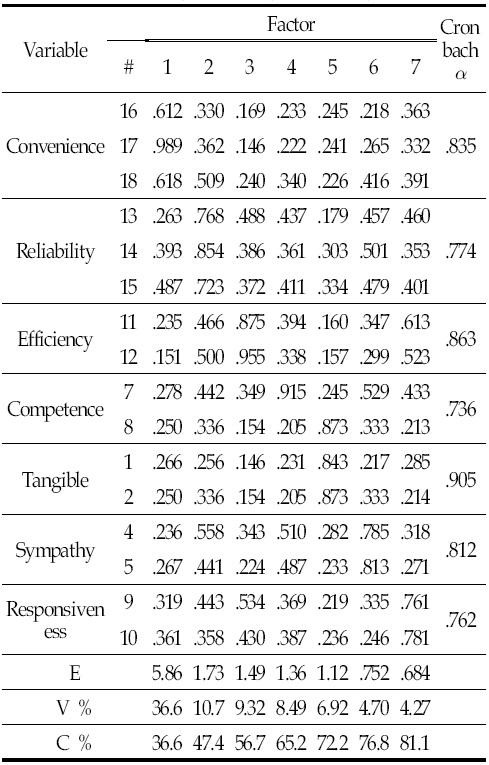
Service Quality : Reliability and Validity
2) Community Attachment
The factor analysis revealed that fuve items were loaded on dependence variable which yielded values between .679~.899, four items were loaded on identity variable values between .683~.904 and three items on social closeness variable values between .584~.764. The final factors consisted on 12 questions; question 5, 11 and 15 have excluded. All of the constructs factor in community attachment displayed good level of inter-item reliability except the social closeness. The result of validity and reliability shows in the <Table 4>.
[Table 4.] Community Attachment : Reliability and Validity
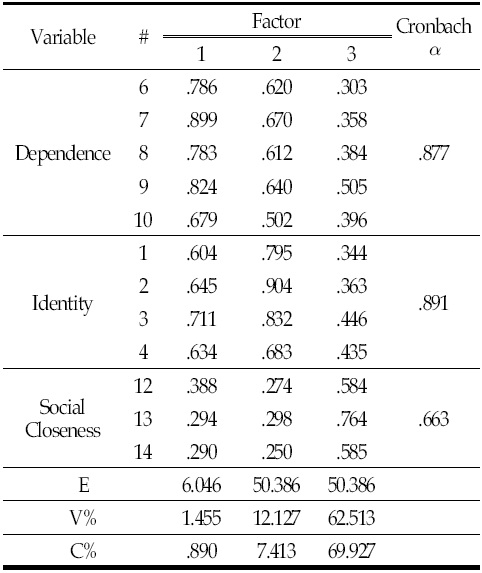
Community Attachment : Reliability and Validity
3) Correlation Analysis
The study conducted correlation analysis to proposed the relationship among the variables. All correlation coefficient is positive. <Table 5> indicates the result of correlation matrix.
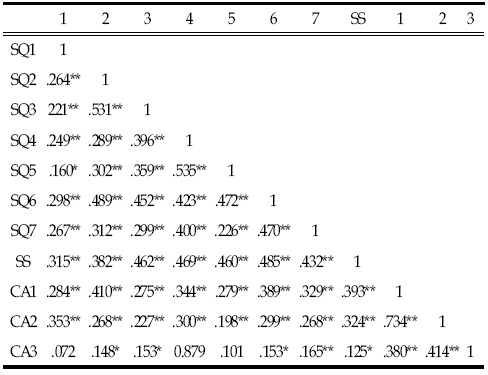
Correlation Matrix
The method of the statistical analysis used in this study are following. Frist, to find difference among the resident’s background characteristics and public service quality, service satisfaction and community attachment, the study used one-way ANOVA. Second, to find validation between the public leisure service satisfaction and community attachment of resident, the study used correlation and regression analysis. The study used SPSS12 Version to verify its statistical treatment.
1) One way ANOVA
The study conducted one-way analyses of variance tests to compare constraints of dimensions with variables of participant’s background characteristics; gender, age, occupation, household income, length of program using and length of residence with service quality, service satisfaction and community attachment. Out of six variables, three variables showed the statistical significance; age, length of program using and length of residence. A repeated measure ANOVA with post-hoc Duncan test was used to determine the variable. <Table 6>, <Table 7> and <Table 8> indicates mean and standard deviation of each factor and the results of ANOVA analysis.
<Table 6> indicates the result of ANOVA by age, in service quality, tangible, sympathy, competence in service quality rejected at significance level below 0.05. In community attachment, identity, dependence and social closeness showed significance level among the different age group.
[Table 6.] ANOVA Analysis by Age
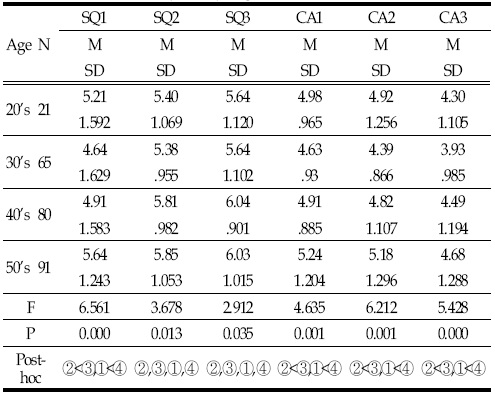
ANOVA Analysis by Age
<Table 7> indicates a result of ANOVA analysis, length in program using did not affect residents’ evaluation of the program quality and service quality. Identity, dependence and social closeness in community attachment rejected at the significance level below 0.05. No differences emerged with the age groups.
[Table 7.] ANOVA Analysis by Length of Program Using

ANOVA Analysis by Length of Program Using
<Table 8> indicates a result of ANOVA by length of residence. Tangible in service quality rejected at significance level below 0.05 and social closeness in community attachment rejected the significance level. Specifically, there were difference of evaluating tangible by length of residence; with respondents who were residence between 16 to 20 years group shows difference with the group who were residence between 1 to 5 years. Also, social closeness by length of residence, with respondent between 16 to 20 years group show difference with the group who were residence between 1 to 5 years.
[Table 8] ANOVA Analysis by Length of Residence
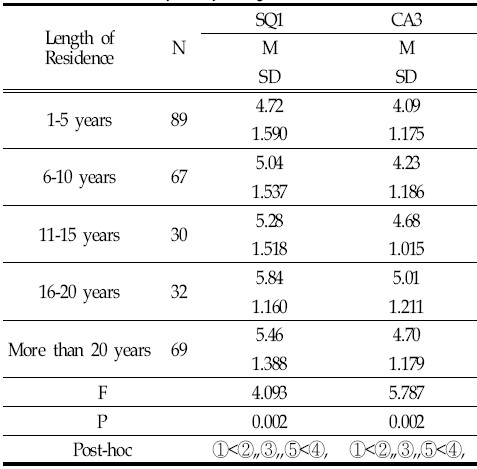
ANOVA Analysis by Length of Residence
2) Regression Analysis
(1) Service Quality and Service Satisfaction
The study conducted the regression analysis to find the validation factors of service quality to resident’s service satisfaction. The regression model revealed as significant level of R²=.424. The regression analysis for service satisfaction produced significant relationship with service tangible, competence, responsiveness, efficiency and convenience. <Table 9> indicates the result.
[Table 9.] Regression Analysis: Service Quality and Service Satisfaction
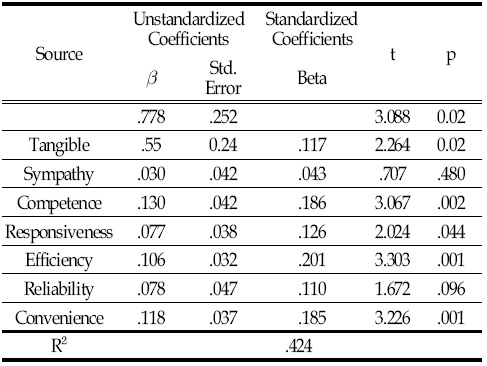
Regression Analysis: Service Quality and Service Satisfaction
(2) Service Satisfaction and Community Attachment
The study conducted the regression analysis to find the validation factors of service satisfaction to community attachment. Each factors of community attachment; identity, dependence, social closeness have been tested. <Table 10> indicates the result of regression for service satisfaction and identity. The result revealed a significant level of R²=3.93. The result indicated that service satisfaction (
[Table 10.] Regression Analysis: Service Satisfaction and Identity
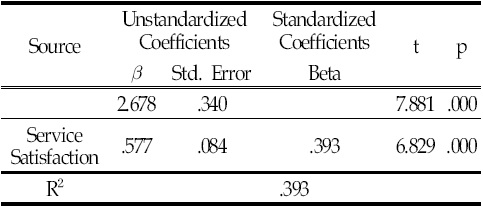
Regression Analysis: Service Satisfaction and Identity
<Table 11> indicates the regression analysis for service satisfaction and dependence. The regression model revealed as significant level of R²=.324. The result indicated that service satisfaction (
[Table 11.] Regression Analysis: Service Satisfaction and Dependence
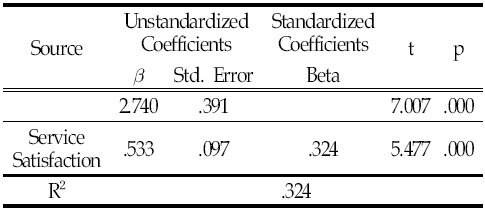
Regression Analysis: Service Satisfaction and Dependence
<Table 12> indicates the regression analysis for service satisfaction and dependence. The regression model revealed as significant level of R²=.125. The result indicated that service satisfaction (
[Table 12.] Regression Analysis: Service Satisfaction and Social Closeness

Regression Analysis: Service Satisfaction and Social Closeness
This study tried to investigate the public leisure program participant’s service satisfaction and the relationship with community attachment. Community center leisure program participant’s background characteristics appeared distinguishable between gender and occupation. Gender rate appeared highly uneven, showing 77.7% female and 14.7% male. Occupation rate also appeared unequal as 55.8% of respondent were housewife. The previous study indicated that resident’s satisfaction with public leisure service were influenced by gender and occupation (Shim, 1994; Jang, 2002; Kang, 2003). However, the study appeared a large portion of female and housewife rate which means the studies may be inappropriate to generalize its impacts and relationship. The limitation also investigated in the previous study by Lee and Lee (2008) investigated the similar results from four community centers located in Kyunggi and Seoul area using samples of 73.3% female, 26.7% male and occupation as 34.7% of housewife.
Buttel, Martinson and Wilkening (1979) suggested that population size and age were the most important indicators of community attachment. The study showed participants above 50s age group appeared the high in community attachment.
The study hypothesized that participants’ perception of public service qualities is positively and directly related to service satisfaction. The result appeared that tangibles, competence, responsiveness, efficiency and convenience reveled the positive influenced on service satisfaction. Reliability and sympathy, however, had no statistically important influenced on public service satisfaction. Through dimensions of service quality have been studied by many scholars, service quality differs from satisfaction primarily because it is quality-specific, while satisfaction deals with quality and non-quality (eg, price) evaluation (Holdford and Patkar, 2003). However, the public services sector still remains distinct from the general business industries as its purpose differs for the profit maximization of the businesses. So, the evaluation of service quality by consumer should be done differently. For example, in the public sector the service provide not for the business markets but for the government’s political process. Moreover, public sector consumers do not always buy the service, but most of time consumers have right to have the service (Shin, 1998).
The result of relationship between service satisfaction with the community attachment indicated service satisfaction is positively influenced on participant’s community attachment. Community attachment appears to be the most strongly associated with social integration that develops over time through interpersonal associations and localized social network (Karsada & Janowitz, 1974). The study site focused on 6 community centers in 5 district zone of Seoul and it could not compensate other resources that can effect community attachment to the residents, so it may be legitimate to extend its relationship in nationwide.
The major objective of the study was to examine the community centers’ leisure program satisfaction and community attachment. The study made three implications to complement the delivery of public leisure service.
First, public leisure program evaluation is needed. Participant’s propensity could be diverse by different region. The officials should carefully review different tendency of their residence and their program.
Second, necessity of marketing strategies plan for public leisure service is needed. Marketing strategies should be differ from commercial leisure service. Government official should aware of these differences and recognize the facts and share their budget for effective marketing plan for future.
Third, officials who are responsible for leisure program in a community center should understand the societal issues around their region and the society. Program development might requires understanding of their customers and target customers based on the societal issues.






